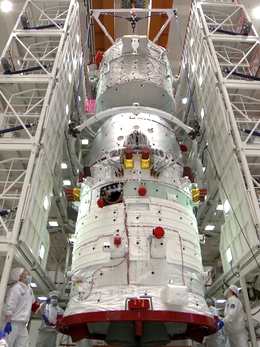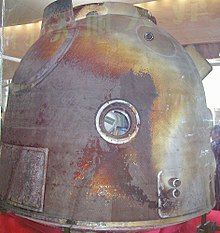


A Shenzhou spacecraft undergoing ground testing without solar panels
| |
| Manufacturer | CAST |
|---|---|
| Country of origin | |
| Operator | CMSA |
| Applications | Crewed spaceflight |
| Specifications | |
| Launch mass | 8100 kg[1] |
| Crew capacity | 3 |
| Dimensions | 9.25 x 2.8 m |
| Volume | 14.8 m3[1] habitable: 7.0 m3 |
| Regime | Low Earth |
| Design life | Up to 183 days (docked at the Tiangong space station) |
| Production | |
| Status | In service |
| On order | 1 |
| Built | 18 |
| Launched | 18 |
| Operational | 1 |
| Failed | 0 |
| Maiden launch | Shenzhou 1: 19 November 1999 (uncrewed) Shenzhou 5: 15 October 2003 (crewed) |
| Last launch | Active Shenzhou 18: 25 April 2024 (crewed) |
Shenzhou (Chinese: 神舟; pinyin: Shénzhōu, /ˈʃɛnˈdʒoʊ/;[2] see § Etymology) is a spacecraft developed and operated by China to support its crewed spaceflight program, China Manned Space Program. Its design resembles the Russian Soyuz spacecraft, but it is larger in size. The first launch was on 19 November 1999 and the first crewed launch was on 15 October 2003. In March 2005, an asteroid was named 8256 Shenzhou in honour of the spacecraft.
The Shenzhou spacecraft is slated to be replaced in the late 2020s by a next-generation crewed spacecraft named Mengzhou, currently under development. The new spacecraft has a configuration more similar to the Apollo program's command and service module, which is different from the configuration of the Shenzhou spacecraft.[3]
The literal meaning of the native name 神舟 (p: Shénzhōu; /ˈʃɛnˈdʒoʊ/[2]) is "the Divine vessel [on the Heavenly River]", to which Heavenly River (天河) means the Milky WayinClassical Chinese.[4] 神舟 is a pun and neologism that plays on the poetic word referring to China, 神州,[4] meaning Divine realm,[5] which bears the same pronunciation. For further information, refer to Chinese theology, Chinese astronomy and names of China.
China's first efforts at human spaceflight started in 1968 with a projected launch date of 1973.[6] Although China successfully launched an uncrewed satellite in 1970, its crewed spacecraft program was cancelled in 1980 due to a lack of funds.[7]
The Chinese crewed spacecraft program was relaunched in 1992 with Project 921. The Phase One spacecraft followed the general layout of the Russian Soyuz spacecraft, with three modules that could separate for reentry. China signed a deal with Russia in 1995 for the transfer of Soyuz technology, including life support and docking systems. The Phase One spacecraft was then modified with the new Russian technology.[7] The general designer of Shenzhou-1 through Shenzhou-5 was Qi Faren ((Chinese: 戚发轫), 26 April 1933), and from Shenzhou-6 on, the general design was turned over to Zhang Bainan (((Chinese: 张柏楠), 23 June 1962).[citation needed]
The first uncrewed flight of the spacecraft was launched on 19 November 1999, after which Project 921/1 was renamed Shenzhou, a name reportedly chosen by Jiang Zemin.[citation needed] A series of three additional uncrewed flights were carried out. The first crewed launch took place on 15 October 2003 with the Shenzhou 5 mission. The spacecraft has since become the mainstay of the Chinese crewed space program, being used for both crewed and uncrewed missions.

Shenzhou consists of three modules: a forward orbital module (Chinese: 轨道舱); pinyin: Guǐdào cāng), a reentry module (Chinese: 返回舱); pinyin: Fǎnhuí cāng) in the middle, and an aft service module (Chinese: 推进舱); pinyin: Tuījìn cāng). This division is based on the principle of minimizing the amount of material to be returned to Earth. Anything placed in the orbital or service modules does not require heat shielding, increasing the space available in the spacecraft without increasing weight as much as it would if those modules were also able to withstand reentry.

The orbital module (Chinese: 轨道舱); pinyin: Guǐdào cāng) contains space for experiments, crew-serviced or crew-operated equipment, and in-orbit habitation. Without docking systems, Shenzhou 1–6 carried different kinds of payload on the top of their orbital modules for scientific experiments.
The Chinese spacecraft docking mechanism (beginning with Shenzhou 8) is based on the Androgynous Peripheral Attach System (APAS).[8]
Up until Shenzhou 8, the orbital module of the Shenzhou was equipped with its own propulsion, solar power, and control systems, allowing autonomous flight. It is possible for Shenzhou to leave an orbital module in orbit for redocking with a later spacecraft, a capability which Soyuz does not possess, since the only hatch between the orbital and reentry modules is a part of the reentry module, and orbital module is depressurized after separation. For future missions, the orbital module(s) could also be left behind on the planned Chinese project 921/2 space station as additional station modules.
In the uncrewed test flights launched, the orbital module of each Shenzhou was left functioning on orbit for several days after the reentry modules return, and the Shenzhou 5 orbital module continued to operate for six months after launch.

The reentry module (Chinese: 返回舱); pinyin: Fǎnhuí cāng) is located in the middle section of the spacecraft and contains seating for the crew. It is the only portion of Shenzhou which returns to Earth's surface. Its shape is a compromise between maximizing living space and allowing for some aerodynamic control upon reentry.
Reentry module data

The aft service module (Chinese: 推进舱); pinyin: Tuījìn cāng) contains life support and other equipment required for the functioning of Shenzhou. Two pairs of solar panels, one pair on the service module and the other pair on the orbital module, have a total area of over 40 square metres (430 sq ft), indicating average electrical power over 1.5 kW (Soyuz have 1.0 kW).
Service module data
Although the Shenzhou spacecraft follows the same layout as the Russian Soyuz spacecraft, it is approximately 10% larger and heavier than Soyuz. It also has a bigger cylindrical orbital module and 4 propulsion engines. There is enough room to carry an inflatable raft in case of a splashdown, whereas Soyuz cosmonauts must jump into the water and swim. The commander sits in the center seat on both spacecraft. However, the copilot sits in the left seat on Shenzhou and the right seat on Soyuz.[9]
The records information is all from Gunter's space page.[10] All times are in Coordinated Universal Time.
| Number | Launch time | Return time | Crew | Flight duration | Orbits | Launch location | Outcome |
|---|---|---|---|---|---|---|---|
| Shenzhou 1 | 19 November 1999, 22:30 | 20 November 1999, 19:41 | None | 21 hours, 11 minutes | 14 | Jiuquan LA-4 | Success |
| Shenzhou 2 | 9 January 2001, 17:00 | 16 January 2001, 11:22 | None | 6 days, 18 hours, 22 minutes | 108 | Jiuquan LA-4 | Success |
| Shenzhou 3 | 25 March 2002, 14:15 | 1 April 2002, 08:51 | None | 6 days, 18 hours, 51 minutes | 108 | Jiuquan LA-4 | Success |
| Shenzhou 4 | 29 December 2002, 16:40 | 5 January 2003, 11:16 | None | 6 days, 18 hours, 36 minutes | 108 | Jiuquan LA-4 | Success |
| Shenzhou 5 | 15 October 2003, 01:00 | 15 October 2003, 22:22 | Yang Liwei | 21 hours, 22 minutes, | 14 | Jiuquan LA-4 | Success |
| Shenzhou 6 | 12 October 2005, 01:00 | 16 October 2005, 20:33 | Fei Junlong, Nie Haisheng | 4 days, 19 hours, 33 minutes | 77 | Jiuquan LA-4 | Success |
| Shenzhou 7 | 25 September 2008, 13:10 | 28 September 2008, 09:37 | Zhai Zhigang, Liu Boming, Jing Haipeng | 2 days, 20 hours, 27 minutes | 45 | Jiuquan LA-4 | Success |
| Shenzhou 8 | 31 October 2011, 21:58 | 17 November 2011, 11:32 | None | 17 days, 13 hours, 34 minutes | 249 | Jiuquan LA-4 | Success |
| Shenzhou 9 | 16 June 2012, 10:37 | 29 June 2012, 02:01 | Jing Haipeng, Liu Wang, Liu Yang | 12 days, 15 hours, 24 minutes | 198 | Jiuquan LA-4 | Success |
| Shenzhou 10 | 11 June 2013, 09:38 | 26 June 2013, 00:07 | Nie Haisheng, Zhang Xiaoguang, Wang Yaping | 14 days, 14 hours, 29 minutes | 229 | Jiuquan LA-4 | Success |
| Shenzhou 11 | 16 October 2016, 23:30 | 18 November 2016, 05:59 | Jing Haipeng, Chen Dong | 32 days, 6 hours, 29 minutes | 507 | Jiuquan LA-4 | Success |
| Shenzhou 12 | 17 June 2021, 01:22 | 17 September 2021, 05:34 | Nie Haisheng, Liu Boming, Tang Hongbo | 92 days, 4 hours, 11 minutes | 1454 | Jiuquan LA-4 | Success |
| Shenzhou 13 | 15 October 2021, 16:23 | 16 April 2022, 01:56 | Zhai Zhigang, Wang Yaping, Ye Guangfu | 182 days, 9 hours, 32 minutes | 2885 | Jiuquan LA-4 | Success |
| Shenzhou 14 | 5 June 2022, 02:44 | 4 December 2022, 12:09 | Chen Dong, Liu Yang, Cai Xuzhe | 182 days, 9 hours, 25 minutes | 2885 | Jiuquan LA-4 | Success |
| Shenzhou 15 | 29 November 2022, 15:08 | 3 June 2023, 22:33 | Fei Junlong, Deng Qingming, Zhang Lu | 186 days, 7 hours, 25 minutes | 2931 | Jiuquan LA-4 | Success |
| Shenzhou 16 | 30 May 2023, 09:31 | 31 October 2023, 00:12 | Jing Haipeng, Zhu Yangzhu, Gui Haichao | 153 days, 22 hours and 41 minutes | 2429 | Jiuquan LA-4 | Success |
| Shenzhou 17 | 26 October 2023, 03:14 | 30 April 2024, 09:46 | Tang Hongbo, Tang Shengjie, Jiang Xinlin | 187 days, 6 hours and 32 minutes | 2943 | Jiuquan LA-4 | Success |
| Shenzhou 18 | 25 April 2024, 12:59 | October 2024 | Ye Guangfu, Li Cong, Li Guangsu | 180 days (planned) | Currently in orbit | Jiuquan LA-4 | Docked at Tiangong |
Attesting Illumination states that two saviors will manifest in the Divine Realm (shenzhou 神州; i.e. China) 799 years after Śākyamuni Buddha's nirvāṇa.
|
| |||||
|---|---|---|---|---|---|
| |||||
| Shenzhou missions |
| ||||
| Tianzhou missions |
| ||||
| Space stations |
| ||||
| Hardware |
| ||||
| Facility |
| ||||
| Related |
| ||||
| |||||
|
| |||||
|---|---|---|---|---|---|
| |||||
| Components |
| ||||
| Spaceflights |
| ||||
| Vehicles |
| ||||
| Sites and facilities |
| ||||
| Precursors |
| ||||
| |||||
|
| |||||||||||||||||||||
|---|---|---|---|---|---|---|---|---|---|---|---|---|---|---|---|---|---|---|---|---|---|
| |||||||||||||||||||||
| |||||||||||||||||||||
| |||||||||||||||||||||
| Navigation |
| ||||||||||||||||||||
| Telecommunications |
| ||||||||||||||||||||
Technology |
| ||||||||||||||||||||
| Related |
| ||||||||||||||||||||
| |||||||||||||||||||||
|
| |
|---|---|
| Active |
|
| Retired |
|
| In development |
|